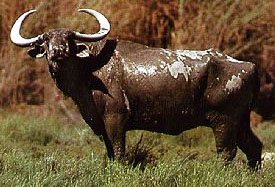|
Exotics: Water Buffalo Cartridges By Chuck Hawks  The wild Asian water buffalo is the heaviest bovine in the world. Adult water buffalo can weigh between 1500 and 2600 pounds on the hoof. A typical weight for mature trophy males might be around 1700 pounds. Water buffalo have the most spectacular horns of all the wild bovines. Both males and females have horns, which are triangular in cross-section, with the bull's horns being heavier. Buffalo horns grow throughout the animal's life, so older animals sport the largest and heaviest horns. Water buffalo may grow curved or straighter, sweeping horns. The curved horns usually score higher (SCI points), but sweeping horns are more impressive.  Water buffalo society is matriarchal. They gather in small family herds of 10 to 20 animals led by a mature cow, although these herds may mingle at times in prime feeding areas. Water buffalo inhabit lowlands and alluvial plains across southern and southeast Asia and also Northern Australia. The latter probably offers the best "free range" hunting in the 21st Century. However, the opportunity to hunt this important species has been expanded by the importation of water buffalo into the Philippines, New Zealand, Argentina, the U.S. and elsewhere. Water buffalo hunting in the U.S. is confined to private hunting preserves and ranches. Fortunately, the Asian water buffalo is usually not as aggressive as its smaller cousin the African Cape Buffalo, but they should not be taken lightly. The chances of being charged are generally low, but like other bovines water buffalo are unpredictable. Water buffalo ordinarily prefer to shun danger and are willing to flee to avoid confrontation with a dangerous predator (including man), but if wounded or cornered they may turn and fight. Very rarely they will attack (sometimes even vehicles!) without provocation. Like I said, they are unpredictable. Always use caution when dealing with wild bovines. (And, for that matter, even domestic dairy bulls.) If a buffalo does decide to charge, the hunter is in serious trouble. A human cannot out run a buffalo, so the only alternative is to stand one's ground and try to kill the animal before it can kill you. It is crucially important to kill or anchor the beast before it can make it to cover or charge. That being the case, it is necessary to use enough gun to break down one of these huge beasts. Traditional cartridge/load advice would suggest one of the powerful 9.3mm or .375 medium bore cartridges with tough premium bullets as a minimum. The .375 H&H Magnum is probably the world's most popular buffalo cartridge and the A-Square Dead Tough, Barnes X-Bullet, Federal/Speer Trophy Bonded Bear Claw, Hornady Dangerous Game, Nosler Partition, Swift A-Frame and Woodleigh Weldcore would be examples of suitable expanding bullets. Based on my own research, I'd expand that minimum to include the .338 Magnum cartridges with premium 250 grain (SD .313) bullets. In general terms, you are looking for a medium or large bore caliber shooting a bullet with a SD of .300 or better and around 4,000 ft. lbs. of muzzle energy. Shoot the heaviest caliber and load that you can handle well. Even better than the powerful medium bore cartridges for anchoring a buffalo or turning a charge is a powerful big bore. The most common of these in the U.S. are the .416 Rem. Magnum, .416 Rigby, .416 Weatherby, .458 Win. Magnum, .458 Lott and .460 Weatherby Magnum, but any caliber in the same general class should be fine. Appropriate bullet weights would include 250 grain in .338 caliber, 286 grain in 9.3mm, 300 grain in .375 caliber, 400 grain in .416 caliber and 450-500 grains in .458 caliber. As always, bullet placement is the key to insuring a quick kill and avoiding trouble. An excellent strategy, if it can be implemented, is to break both of the buffalo's shoulders. It cannot escape or charge with both shoulders broken. With the animal immobilized a finishing shot can be delivered safely and humanely if required. A lung shot, highly recommended for most big game species, will also kill buffalo and the heart/lung area makes a large target. However, a buffalo is a big animal and it can live for quite a while before its great lungs fill with blood and it expires. A buffalo is capable of wreaking tremendous havoc in the final minutes of its life, so a lung shot is best when the hunter can arrange to stay out of the buffalo's reach while it is dying and also when there is no cover in which the buffalo can take refuge. Entering thick brush seeking a possibly wounded buffalo is definitely to be avoided. Because they offer fast follow up shots, double barreled or repeating rifles are the best choice when hunting any potentially dangerous game. A strong single shot rifle, such as the Ruger No. 1, in one of the calibers recommended above certainly has the power to kill buffalo, but reloading for a follow-up shot is slower and less certain, particularly under great stress, than with a repeating rifle. Ideally, shots at water buffalo (or any potentially dangerous game) should be taken at ranges between 50 and 150 yards. A low powered scope, either a 2.5x fixed power model or a 1-4x variable power model, offers the best combination of accuracy, a large field of view and fast target acquisition. For those few hunters that eschew optics and insist on using iron sights, a large aperture ("ghost ring") or traditional "express" open rear sight is probably the best bet combined with some sort of brass or ivory bead front sight. When choosing buffalo cartridges, rifles and sights make sure to select a combination that you can use accurately under stress. As always, but even more so when hunting potentially dangerous game, accurate shot placement is the key to clean, safe kills. |